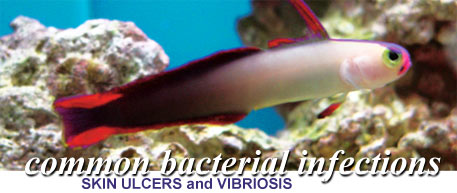
While "bad" bacteria are ubiquitous in your aquarium, you can keep your fish from being affected by them. The key to dealing with any bacterial infection is early recognition and treatment. Of course, prevention through
careful introduction of new fish, plants and water, as well as maintaining a healthy, stress-free environment for your fish, is still the best course of action.
Part one of this two-part article discussed identification and
treatment of fin rot, and fish tuberculosis - some of the more common bacterial infections in fish. This article covers skin ulcers and Vibriosis.
Skin Ulcers
Signs: Ulcers usually show up as raw opened areas on the skin. They often have reddened edges and may be associated with other symptoms of systemic infection or disease.
Cause: Aeromonas, Pseudomonas, Mycobacterium and Vibrio
Transmission: The bacteria are commonly found in the water and will invade a wound or skin injury on an otherwise healthy fish.
 Predisposing factors: Previously damaged skin, poor water conditions, and stress can all lead to an increase in ulcers.
Predisposing factors: Previously damaged skin, poor water conditions, and stress can all lead to an increase in ulcers.
Treatment: Antibiotic baths coupled with anti-fungal baths containing phenoxyethanol are the most common treatments. Improving water quality, reducing stress, and decreasing the risk of injury are all very important in reducing the incidence of ulcers.
Vibriosis
Vibriosis is most often found in marine or brackish water fish but can occasionally be found in tropical species as well.
Signs: There are two forms of vibriosis.
Acute Form: Death may occur suddenly, before any signs are noticed. Symptoms may include increased respiration, loss of appetite, lethargy, skin hemorrhages, and death. Post mortem exams may reveal enlarged internal organs, but without a diagnostic test, this disease is difficult to distinguish from other bacterial infections.
Chronic Form: Exophthalmos, ulcers, and intestinal inflammation in fish that have died.
Transmission: Fish contract the bacteria Vibrio anguillarum through open sores or feeding on dead fish that died from the disease.
Treatment: The best treatment includes the oral antibiotics chloramphenicol or furazolidone.
Summary
These are just a few of the most common bacterial infections that can infect fish. After reviewing the list of infections, it is very clear that most bacterial infections are caused by a few similar situations, and that following a few basic precautions can prevent most of these infections. The precautions include maintaining excellent water quality at all times, quickly removing any dead or diseased fish from the tank, treating all diseased fish, never introducing diseased or sick fish into your community tank, and preventing injuries from fighting or unsuitable habitat. If these basic guidelines are followed, bacterial infections will be a very rare occurrence in your tank.
References
Bailey, M; Burgess, P. Tropical Fishlopedia. Howell Book. New York; 2000.
Burgess, P; Bailey, M; and Exell, A. A-Z of Tropical Fish. Howell. New York; 1998.
Burgess, WE; Axelrod, HR; Hunziker III, RE. Dr. Burgess's Mini Atlas of Marine Aquarium Fishes. TFH. Neptune City, NJ; 1997.
Alderton, D. The Complete Guide to Tropical Aquarium Fish Care. Howell Books. New York; 1998.
|